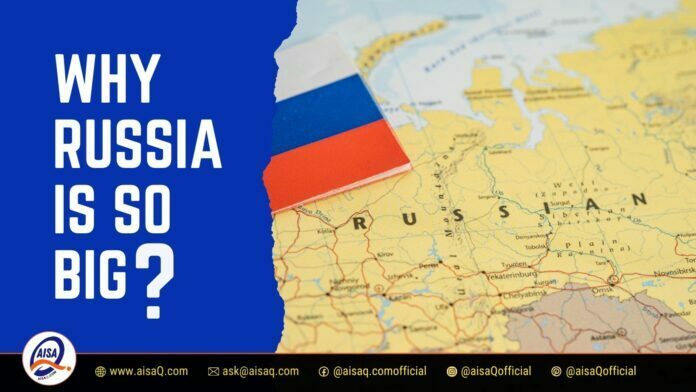Why Russia Is So Big?
Russia is the largest country in the world, covering an area of over 17 million square kilometers. The country’s sheer size is enough to leave many people in awe and wonder how it became so big. In this article, we will explore the reasons why Russia is so big, including its geographical features, history, and political factors.
Table of Contents
Why Russia Is So Big?
Introduction
Russia is the largest country in the world, covering more than one-eighth of the Earth’s land area. It spans across 11 time zones and is home to over 144 million people. But why is Russia so big? In this article, we will explore the historical and geographical factors that have contributed to the size of Russia.
Historical Context
The Rise of the Russian Empire

Russia’s history is marked by conquest and expansion. In the 9th century, the Slavic tribes of Eastern Europe united under the leadership of the Kievan Rus, establishing a powerful medieval state. Over time, the Kievan Rus fragmented into smaller principalities, but in the 16th and 17th centuries, a new centralized state emerged: the Tsardom of Russia.
Under Ivan IV, also known as Ivan the Terrible, Russia expanded into Siberia and established a presence in the Far East. The reign of Peter the Great marked a turning point in Russian history. Peter modernized the country and transformed it into a major European power. He founded the city of St. Petersburg, which served as Russia’s capital for two centuries.
Expansion under the Tsars
In the 18th and 19th centuries, the Russian Empire continued to expand. Catherine the Great annexed Crimea and parts of Poland, while Alexander II conquered territories in Central Asia. The Russian Empire became the largest contiguous empire in history, stretching from Europe to Asia.
Geographical Factors

Climate and Landscapes
Russia’s size is partly due to its diverse landscapes and extreme climate. The country spans from the Arctic Ocean to the Caspian Sea, encompassing a wide range of environments. The Russian Far East is covered by dense forests, while the Siberian region is characterized by vast plains and frozen tundra. The southern regions of Russia are home to mountain ranges and arid steppes.
Natural Resources
Russia’s size is also connected to its vast reserves of natural resources. The country is rich in minerals such as oil, gas, coal, and gold. It has some of the world’s largest reserves of timber, diamonds, and platinum. The exploitation of these resources has been a significant factor in Russia’s economic development.
The Soviet Union and Beyond
Territorial Changes in the 20th Century
The 20th century brought significant territorial changes to Russia. In 1917, the Russian Revolution led to the overthrow of the Tsarist regime and the establishment of the Soviet Union. The Soviet Union expanded its territory by annexing neighboring countries such as Belarus, Ukraine, and the Baltic states.
After the collapse of the Soviet Union in 1991, Russia went through a period of political and economic instability. However, the country maintained its vast territorial expanse. Today, Russia is a federal semi-presidential republic consisting of 85 federal subjects.
Modern-Day Russia
Russia remains one of the world’s largest economies and a major global power. Its geopolitical influence extends beyond its borders, and the country plays a prominent role in international affairs. However, Russia faces a number of challenges, including demographic decline, corruption, and strained relations with Western powers.
FAQs:

Is Russia the largest country in the world?
• Yes, Russia is the largest country in the world.
Russia covers more than 17 million sq miles and is the largest country in the world. It has the most land in the world, but barely any population on it, making it one of the least populated countries in the world.
How many continents does Russia span?
• Russia spans two continents, Europe and Asia.
What are the major mountain ranges in Russia?
• The major mountain ranges in Russia include the Ural Mountains and the Caucasus Mountains.
Why did Russia expand into Siberia?
• Russia expanded into Siberia to gain access to fur trade and other resources in the region.
Russia expanded into Siberia to gain access to fur trade and other resources in the region.
• The collapse of the Soviet Union was caused by a combination of economic stagnation, political reforms, and nationalist movements in the republics of the Soviet Union.
What are some of the challenges facing modern-day Russia?
• Modern-day Russia faces challenges such as demographic decline, corruption, and strained relations with other nations.
How does Russia’s size and influence shape global politics?
• Russia’s size and influence give it significant geopolitical power, and its actions can have a significant impact on international politics and economics.
Conclusion
The size of Russia is a product of both historical and geographical factors. Its conquests and expansion throughout history have
applied pressure on neighboring territories, and its diverse landscapes and natural resources have enabled economic growth and development. The Soviet Union’s territorial expansion in the 20th century further contributed to the size of Russia.
Today, Russia’s vast expanse provides both opportunities and challenges. Its natural resources continue to be a significant factor in its economy, but the country’s demographic decline and political tensions with other nations pose significant challenges.
Despite its challenges, Russia remains an important player in the global community, with a rich cultural and historical legacy. Its size and influence will continue to shape international politics and economics for years to come.
If you want to explore other interesting questions on our site, then don’t forget to bookmark and visit the sitemap.


